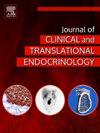巨催乳素瘤的长期初级药物治疗:不同卡麦角林剂量的比较
IF 3.3
Q1 ENDOCRINOLOGY & METABOLISM
Journal of Clinical and Translational Endocrinology
Pub Date : 2025-09-01
DOI:10.1016/j.jcte.2025.100418
引用次数: 0
摘要
目的多巴胺激动剂是治疗大多数巨大催乳素瘤的一线药物。本研究的目的是评估多巴胺激动剂给药策略对巨大催乳素瘤患者生化(催乳素正常化)和放射学(肿瘤大小缩小)反应的不同影响。设计:单中心回顾性现实生活23年随访研究。方法对33例巨大催乳素瘤(≥4 cm)患者进行初步药物治疗。我们评估了垂体功能,治疗和不同剂量方案对催乳素正常化和肿瘤大小的影响,手术对并发症的影响以及对耐药患者放疗的影响。结果33例患者(平均年龄42岁)中,男性27例,女性6例。基线平均催乳素浓度为7506µg/L。30例患者选择卡麦角林治疗,2例选择特古利,1例选择溴隐亭治疗。在接受高剂量卡麦角林(每周3.5 mg)的患者中,我们观察到与接受低剂量(每周1-2.5 mg)的患者相比,催乳素的正常化速度更快,但肿瘤大小的缩小速度并不快。共有9/33例(27%)患者因并发症接受手术,其中3例因部分耐药而接受Leksell伽玛刀照射。在4/33的患者中,我们能够在10-20年的治疗后停止药物治疗。其余29/33例患者继续接受药物治疗。结论多巴胺激动剂是安全的,仅在2/3的药物治疗患者中作为一线治疗。高剂量卡麦角林加速催乳素正常化,但对早期肿瘤缩小没有额外的益处。本文章由计算机程序翻译,如有差异,请以英文原文为准。
Long-term primary pharmacotherapy of giant prolactinomas: A comparison of different cabergoline dosages
Objectives
Dopamine agonists serve as first-line therapies for most giant prolactinomas. The objective of this study was to assess the differential impact of dopamine agonist dosing strategies on biochemical (prolactin normalisation) and radiological (tumour size reduction) responses in patients with giant prolactinomas.
Design
A single-centre retrospective real-life 23-year follow-up study.
Methods
Thirty-three patients with giant prolactinomas (≥ 4 cm) were treated with primary pharmacotherapy. We assessed pituitary function, the effect of therapy and different dosing regimens on prolactin normalisation and tumour size, the effect of surgery for complications and the effect of radiotherapy in resistant patients.
Results
Out of thirty-three consecutive patients (mean age 42 years), 27 were men, and 6 were women. The baseline mean prolactin concentration was 7506 µg/L. The treatment of choice was cabergoline in 30 patients, terguride in 2 patients, and bromocriptine in 1 patient. In patients receiving a high dose of cabergoline (3.5 mg weekly), we observed a faster normalisation of prolactin but not faster reduction in tumour size than in patients receiving a low dose (1–2.5 mg weekly). A total of 9/33 (27 %) patients underwent surgery for complications, 3 of whom were irradiated by Leksell gamma knife for partial resistance. In 4/33 patients we were able to stop pharmacotherapy after 10–20 years of treatment. The remaining 29/33 patients remained on pharmacological treatment.
Conclusions
Dopamine agonists are safe and only required treatment in 2/3 of patients treated with pharmacotherapy as a first-line treatment. Higher doses of cabergoline accelerate prolactin normalisation but do not confer additional benefit in early tumour shrinkage.
求助全文
通过发布文献求助,成功后即可免费获取论文全文。
去求助
来源期刊

Journal of Clinical and Translational Endocrinology
ENDOCRINOLOGY & METABOLISM-
CiteScore
6.10
自引率
0.00%
发文量
24
审稿时长
16 weeks
 求助内容:
求助内容: 应助结果提醒方式:
应助结果提醒方式:


